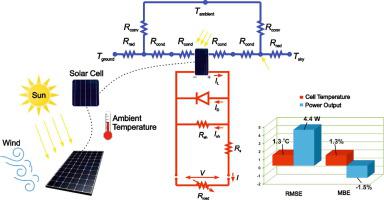Applied Thermal Engineering ( IF 6.1 ) Pub Date : 2021-06-10 , DOI: 10.1016/j.applthermaleng.2021.117224 Kaan Yaman , Gökhan Arslan

|
Photovoltaic (PV) performance fluctuates greatly due to varying meteorological, physical, and operational conditions. Therefore, there is a need to develop accurate predictions without unjust simplification of how it will perform in real conditions. In this paper, a detailed mathematical model was developed to determine the thermal and electrical parameters of a PV module under transient conditions. The model simultaneously solved a thermal model based on thermal resistance circuit and an electrical model based on an equivalent electrical circuit. In order to evaluate the proposed model in a wider way, the experimental validation was made by taking into account different meteorological conditions. The root mean square error (RMSE) and mean bias error (MBE) values of the solar cell temperature for a winter day were 1.341 ℃ and 1.916%, respectively. For a summer day, these values were 1.296 ℃ and 0.855%, respectively. The RMSE and MBE values of the power output for a winter day were 5.094 W and −0.022%, respectively. For a summer day, these values were 3.913 W and −2.499%, respectively. Experimental validation showed that the errors in the proposed model were within an acceptable level. The model was then implemented to investigate the distribution of thermal resistance in the PV module. The results show that the radiative thermal resistance for the winter and summer days is 80.3% and 70.7% of the total thermal resistance, which includes conduction, convection, and radiation, respectively, while the conductive thermal resistance has a negligible effect on the total resistance. A long-term evaluation of the model was used to examine the highest temperatures and electrical power output that the PV module can reach in various weather conditions. According to the findings, the wind speed was not dominant in effecting the cell temperature compared to the solar radiation and ambient temperature. As the intensity of solar radiation got higher, less electrical power was produced than its capacity due to an increased cell temperature. Finally, it was compared with previous models in the relevant literature to investigate the effect of different approaches. Accordingly, it is revealed that the proposed model provides a significant improvement in both the cell temperature and power output prediction.
中文翻译:

光伏 (PV) 模块热电耦合性能的详细数学模型和实验验证
由于气象、物理和操作条件的变化,光伏 (PV) 性能波动很大。因此,需要开发准确的预测,而不会对实际条件下的表现进行不公正的简化。在本文中,开发了一个详细的数学模型来确定瞬态条件下 PV 模块的热和电参数。该模型同时求解基于热阻电路的热模型和基于等效电路的电气模型。为了以更广泛的方式评估所提出的模型,通过考虑不同的气象条件进行了实验验证。冬日太阳能电池温度的均方根误差(RMSE)和平均偏差误差(MBE)分别为1.341℃和1.916%。对于夏季的一天,这些值分别为 1.296 ℃ 和 0.855%。冬日输出功率的 RMSE 和 MBE 值分别为 5.094 W 和 -0.022%。对于夏日,这些值分别为 3.913 W 和 -2.499%。实验验证表明,所提出模型的误差在可接受的范围内。然后实施该模型以研究 PV 模块中的热阻分布。结果表明,冬季和夏季的辐射热阻分别占总热阻的80.3%和70.7%,包括传导、对流和辐射,而传导热阻对总热阻的影响可以忽略不计. 该模型的长期评估用于检查 PV 模块在各种天气条件下可以达到的最高温度和电力输出。根据研究结果,与太阳辐射和环境温度相比,风速在影响电池温度方面并不占主导地位。随着太阳辐射强度变高,由于电池温度升高,产生的电能少于其容量。最后,将其与相关文献中的先前模型进行比较,以研究不同方法的效果。因此,表明所提出的模型在电池温度和功率输出预测方面都提供了显着改进。与太阳辐射和环境温度相比,风速在影响电池温度方面并不占主导地位。随着太阳辐射强度变高,由于电池温度升高,产生的电能少于其容量。最后,将其与相关文献中的先前模型进行比较,以研究不同方法的效果。因此,表明所提出的模型在电池温度和功率输出预测方面都提供了显着改进。与太阳辐射和环境温度相比,风速在影响电池温度方面并不占主导地位。随着太阳辐射强度变高,由于电池温度升高,产生的电能少于其容量。最后,将其与相关文献中的先前模型进行比较,以研究不同方法的效果。因此,表明所提出的模型在电池温度和功率输出预测方面都提供了显着改进。将其与相关文献中的先前模型进行比较,以研究不同方法的效果。因此,表明所提出的模型在电池温度和功率输出预测方面都提供了显着改进。将其与相关文献中的先前模型进行比较,以研究不同方法的效果。因此,表明所提出的模型在电池温度和功率输出预测方面都提供了显着改进。











































 京公网安备 11010802027423号
京公网安备 11010802027423号